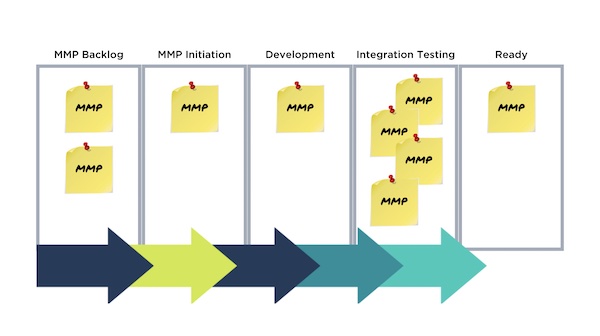
by Sanjiv Augustine and Audrey Scheere of LitheSpeed, and co-authors of “From PMO to VMO: Managing for Value Delivery“.
In today’s turbulent world, businesses and employees alike are struggling to evolve optimal ways of working. The “great resignation” has forced wake up calls across the board. We’re all seeking ways to rebalance our work lives with our personal commitments and passions. One thing is clear from psychology and management: focused, rewarding work that flows can be an intrinsic source of motivation and joy.
Managing our workloads by organizing our multiple responsibilities is crucial to our productivity and our happiness. What are some straightforward, effective ways to get a handle on things? As the old adage goes, we can’t manage what we don’t measure. It follows that we certainly can’t manage what we can’t see. So, to organize our work and our lives, it is useful to explore the concept of visual management and apply it to see, manage and measure our work.
A Visual Management System (VMS) is a core foundational element of Lean Thinking derived from Toyota’s Lean management system, and a popular management technique employed worldwide across industries. It is based on the fundamental concept that we as people process more information visually; and that we learn faster from the visual presentation of information than by any other means.
In a product delivery or program management context, VMSs help us manage work by visually communicating the work being done along with desired business outcomes, expectations, standards, performance, and alerts. Fundamentally, these systems help us visualize all the work in process and enable tracking and monitoring the flow of value. VMSs also help us identify any impediments to value flow so that we can resolve them in a collaborative manner.
Visualization to Improve Flow
Flow means moving along steadily and readily in a continuous stream. Visualizing and managing our flow is essential to achieving faster and more consistent delivery of value towards business outcomes. In a Lean or Agile context, flow is how our work progresses through our program or product management system. In order to track the flow of work through our system, we need to visualize our work as it flows through the system and our organization, beginning with when a customer requests a product feature or service, and ending when we realize business value by having that feature or service delivered to the customer.
When our system is working well, or has good flow, value tends to move steadily and predictably. When that flow is interrupted, and our work starts, stops, or is blocked; waste increases. The delivery of value to our customers is interrupted and delayed as well. An Agile mindset calls for a steady, consistent flow that results in the reliable delivery of value to our customers, teams, and stakeholders.

A simple VMS, as illustrated, makes all our work visible, and also immediately identifies bottlenecks in our end to end process. Blockages and delays in flow become readily apparent when they are made visible, such as the above bottleneck in Integration Testing.
Once we know where these bottlenecks are, we can resolve them in triage fashion, addressing the most critical ones first. Combined with flow-based metrics like the lead time for features, defects, risks and debts, leaders get a real-time sense of where value is flowing, where it is blocked or delayed, and what they might be able to do about it.
Limiting Work in Process (WIP) to Speed up
Imagine a crowded bumper-to-bumper highway at rush hour in a major city. Nobody is getting anywhere quickly. The highway, however, is being efficiently utilized; almost every square foot of this very expensive resource has a car on it. Given this highly efficient utilization, why are we not able to move faster? The reason is that utilization and throughput are negatively correlated.
The higher the shared utilization of a scarce resource, the slower we go, with lower throughput. Traffic systems, networking systems, and queuing theory in general predict this behavior. However, this same thinking has not been applied to tracking and managing program flow until fairly recently.
From queuing theory, Little’s Law tells us, Cycle Time = WIP/Average Completion Rate. So, to get the work in our systems moving faster, we can either reduce WIP (represented by the total active work in the system) or increase the average rate at which we complete work. Increasing the rate at which we complete product work is obviously quite difficult.
The most straightforward way to reduce the cycle time of work flowing through the system and to increase the throughput of value through our system is to limit our WIP. Limiting WIP and improving flow in our system is best done by chunking work into small deliverables, often called Minimum Marketable Products (MMPs). An MMP is a small piece of our product or service that delivers immediate value for our customers.
A structured VMS that allows us to visualize work, identify and resolve bottlenecks and track value delivery has the benefit of creating flow and focus, both of which are linked to productivity and happiness.
Read more about Visual Management Systems and Flow in “From PMO to VMO: Managing for Value Delivery“.
Sanjiv Augustine is founder and CEO of LitheSpeed and the Agile Leadership Academy. He is an entrepreneur, industry-leading agile and lean expert, speaker, management consultant, and trainer. Augustine has served as a trusted advisor over the past twenty years to executives and management at leading firms and agencies. He is author of the books “Managing Agile Projects and Scaling Agile”, and his latest book is “From PMO to VMO: Managing for Value Delivery“.
Audrey Scheere is the senior vice president of marketing and training at LitheSpeed, where she directs the team’s strategic initiatives and portfolio of services. Scheere has been a project consultant for ten years, focusing on media and communications. She is co-author of “From PMO to VMO: Managing for Value Delivery“.
The post Flow, Focus And The Pursuit Of Happiness appeared first on d0llars.
source https://d0llars.com/flow-focus-and-the-pursuit-of-happiness/
No comments:
Post a Comment